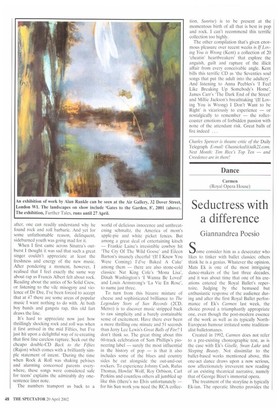Dance
Carmen (Royal Opera House)
Seductress with a difference
Giannandrea Poem
Some consider him as a desecrater who likes to tinker with ballet classics; others think he is a genius. Whatever the opinion, Mats Ek is one of the most intriguing dance-makers of the last three decades, and it was about time that one of his creations entered the Royal Ballet's repertoire. Judging by the bemused but enthusiastic response of the audience during and after the first Royal Ballet performance of Ek's Carmen last week, the choice proved a triumphantly appropriate one, even though the post-modern essence of the work as well as its typically NorthEuropean humour irritated some traditionalist balletomanes.
Created in 1992, Carmen does not refer to a pre-existing choreographic text, as is the case with Ek's Giselle, Swan Lake and Sleeping Beauty. Not dissimilar to the ballet-based works mentioned above, this one-act dance draws upon a now serious, now affectionately irreverent new reading of an existing theatrical narrative, namely that of George Bizet's immortal opera.
The treatment of the storyline is typically Ek-ian. The operatic libretto provides the pretext for the exploration and exploitation of different issues. Parallels and references to other narratives, whether they be strictly related or not to the selected source, interact with each other, generating a multilayered performance where every image can be interpreted in myriad different ways. All the characteristic features of a post-modern work are here: montage, pastiche, irony and parody.
The eponymous heroine is no longer the quintessential seductress, but a complex and often amusing patchwork of different types. Butch and blunt, she wanders around with a provocatively big cigar in her mouth, acting like a rough female equivalent of her compatriot Don Juan, or like some faded Hollywood diva hamming it up in a Technicolor B-movie. Her actions are framed by a group of garishly dressed women and, more significantly, by a bunch of not so garishly clad macho men who, despite a great deal of virile shouting and acting, simply melt in her presence. The only exceptions are Don Jose, who becomes a tender wimp, the toreador Escamillo, portrayed as a flashily clothed, lady-killer out of a 1970s rock band, and a haunting female presence referred to as 'M', which stands for both Michaela, Don Jose's fiancée in the opera, and Mother, in the name of whom Michaela attempts to rescue her lover.
Ek's imaginative reworking of the original narrative, however, goes far beyond a mere adaptation of the operatic libretto. As usual, Ek creates a significant layer of meaning by taking full advantage of the musical narrative. In this particular case, the musical narrative is twofold, for the score used is Rodion Shchedrine's arrangement of Bizet's opera. This arrangement, which had already been used for one of the most popular balletic versions of Carmen, allows Ek to play with the expressiveness of the modern re-orchestration and that of the original operatic tunes. The gloomy, funereal new version of the celebrated habanera, for instance, underscores the opening sequence, where we see Don Jose ready to be executed for having killed Carmen.
Similarly, the re-orchestration of the famous 'flower' aria accompanies a sort of Chaplinesque dream sequence, where the unlucky male protagonist sees himself happily married to the object of his passion — even though it is she who smokes the cigar, like a true bridegroom, and he who carries the wedding bouquet.
The artists of the Royal Ballet responded more than well to both the theatrical and choreographic demands of the work. Sy!vie Guillem as Carmen was absolutely stunning. Having worked with Ek before, she knows how to respond to the interpretative and technical demands of the role. Next to her, the Italian Massimo Murru is another accomplished Ek interpreter — his 'naked' performance in Ek's Giselle at La Scala caused a national controversy in Italy. Still,
I found that on the opening night he did not make the most of Don Jose, and overlooked both the lyrical and the subtly comical traits of the part, particularly in the dream sequence mentioned above. Jonathan Cope, on the contrary, was perfect as the flashy Escamillo, and proved to be a truly versatile artist. Zenaida Yanowsky as 'M' was pretty sensational, too, and, in my view, the one who really grasped and understood the subtleties of Ek's style in full.
Carmen came as the final item of a triple bill made up of works I have reviewed recently — William Forsythe's In the Middle Somewhat Elevated, in which Marianela Nunez danced with unique bravura and gusto, and Nacho Duato's utterly tedious Por Vos Muero, about which I have nothing to say.







































































 Previous page
Previous page